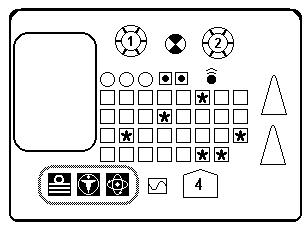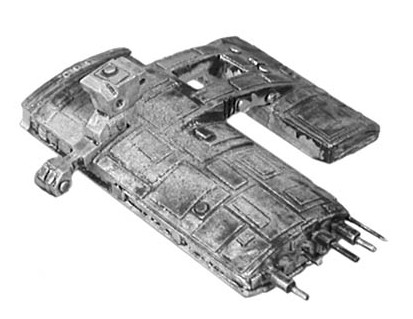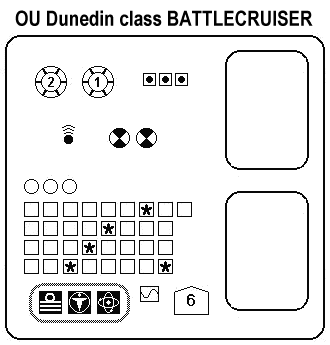|
OUDF Public Beta-Test The systems and ship designs for the OUDF indicated below are beta-test versions and any final version that would appear in print may be different. Please use these new systems and designs in your battles and your feedback is appreciated.
Additional Playtest fleets and SSDs for new Full Thrust miniatures are available through the FT Fleet Resource.
OUDF Basic Hulls
|
||
|
Snake class HEAVY FRIGATE Technical Specifications Classification : Frigate Displacement : 2400 Tonnes [MASS Factor 24] Hull Type : Average [Hull Integrity 7] Crew : 5 Officers, 19 Ratings Armament : 1 Class 2, 2 Class 1 Batteries Defences : 1 Point Defence System, Grade 1 Armour
Sensor Suite : Standard sensors, 1 Fire Control System |
Service Details |

|
|
The Snake class was designed to meet an OUDF specification for a very fast, heavily armed Frigate, capable of out-running anything it couldn't out-fight, and out-fighting anything it couldn't out-run. Lee-Lu shipyards proposed solution was based on grafting the drives of their standard River/Freemantle class Patrol Vessel onto a purpose-built hull only half the size. Although highly successful due to its use of standard components, it is the least popular of all the BORON designs, due to cramped ( by OU standards ) accommodation.
|
||
|
Spider class TORPEDO BOAT Technical Specifications
Classification : Frigate Hull Type : Average [Hull Integrity 7] Crew : 4 Officers, 20 Ratings Armament : 1 Pulse Torpedo Tube Defences : 1 Point Defence System, Grade 1 Armour Sensor Suite : Standard sensors,1 Fire Control System Drive Systems : Main Drive rating 7, FTL (Jump) Drive |
Service Details |
 |
|
The Spider class , although externally indistinguishable from its predecessor, the Snake class, is actually a new design. Lessons learnt from the Snake class were incorporated into it, and the armament was completely revised. The Spider class is designed specifically to attack the most heavily screened enemies, and operates in packs. Popularly known as the "Banzai Boats".
|
||
|
Freemantle class Technical Specifications Classification : Destroyer Displacement : 3200 Tonnes [MASS Factor 32] Hull Type : Very Strong [Hull Integrity 16] Crew : 5 Officers, 27 Ratings Armament : 1 Class 1 Battery Defences : Grade 2 Armour Sensor Suite : Standard sensors, 1 Fire Control System Drive Systems : Main Drive rating 5, FTL (Jump) Drive |
Service Details |
|
|
The Freemantle Class was the first of the BORON designs, and has been the subject of numerous minor changes to improve its performance since the first one was laid down in 2162. Unlike all other modular designs, only the original Freemantle class is capable of operating without a payload module being fitted. The Jump drive has significant excess capacity, and is operated in a de-tuned mode to conserve reliability and increase range. Freemantle class patrol vessels are capable of taking on all but the most heavily armed pirates or smugglers, but are primarily patrol, police and customs vessels, with no significant military capability. This has proved a very popular design in both para-military and tio a lesser extent, commercial service, with significant numbers being produced for export.
|
||
|
River class DESTROYER Technical Specifications Classification : Destroyer Displacement : 4000 Tonnes [MASS Factor 40] including payload module Hull Type : Strong [Hull Integrity 16] Crew : 5 Officers, 27 Ratings + Module Crew Armament : 1 Class 1 Battery ( + module) Sensor Suite : Standard sensors, 1 Fire Control System (+ module) Drive Systems : Main Drive rating 4, FTL (Jump) Drive |
Service Details |
|
|
The Freemantle Class when fitted with a payload module is known as the River class. The base design's FTL over-capacity is easily able to cope with the additional 25% mass, though the manouvre drive is of necessity constrained to operate at slower speeds. Hull integrity suffers somewhat too, the additional mass contributing nothing to the overall ship's strength. Most River class ships of the OUPF are fitted with either cargo, survey, or research payload modules, though sometimes a Gunpack is fitted as a nasty surprise for Pirates. The River class are indeed "maids of all work" for the OUDFN, acting in the roles of light cruiser, escort cruiser, destroyer and attack transport with equal facility.
|
||
|
Numbat class LIGHT CRUISER Technical Specifications Classification : Light Cruiser Displacement : 6200 Tonnes [MASS Factor 62] including payload module Hull Type : Average [Hull Integrity 19] Crew : 8 Officers, 46 Ratings + Module Crew Armament : 1 Class 2 Battery, 1 Class 1 Battery ( + module) Defences : Grade 2 Armour, 1 Point Defence System, Level 1 Screens (+ module ) Sensor Suite : Standard sensors,2 Fire Control Systems (+ module) Drive Systems : Main Drive rating 4, FTL (Jump) Drive |
Service Details |
|
|
The Numbat class is a further development of the River/Freemantles. A new, more powerful manouevre drive was fitted to a slightly expanded River hull. The Numbats never did reach their design acceleration, and this failure led to the development of the Snake/Spiders, where the Freemantle's proven original drive was used on a cut-down hull with rather more success. Despite this failure, the Numbats have been quite successful in the role of light cruisers, and are popular ships amongst their crews. 2 Numbats in OU service and most manufactured for export have been fitted on a semi-permanent basis as diplomatic transports, with VIP payload modules.
|
||
|
Tuvalu Block I class HEAVY CRUISER Technical Specifications Classification : Heavy Cruiser Displacement : 8100 Tonnes [MASS Factor 81] including 2 payload modules Hull Type : Average [Hull Integrity 24] Crew : 9 Officers, 56 Ratings + Module Crew Armament : 2 Class 2 Batteries, 1 Class 1 Battery ( + modules) Defences : Grade 3 Armour, 2 Point Defence Systems, Level 1 Screens (+ modules ) Sensor Suite : Standard sensors,2 Fire Control Systems (+ modules) Drive Systems : Main Drive rating 4, FTL (Jump) Drive |
Service Details |
|
|
The Tuvalu class was the first of the BORON designs not to be directly derived from the Freemantle class. It was conceived as a "double Freemantle", each vessel having at least twice the capability of the smaller ships. The design was not deemed a great success, as the problems involved in having two modules on one ship caused the programme cost to blow out alarmingly, and their expense is very high - comparable to more conventional designs. Production was soon switched to the Block II design, which traded in the ability to carry two modules for a greatly increased structural strength. Recently, however, the Block I Tuvalu has been reinstated in production, the resultant ships usually carrying two different types of pod, one military, one not, so they become self-escorting troop transports, self-escorting cargo carriers and so on.
|
||
|
Tuvalu Block II class HEAVY CRUISER Technical Specifications Classification : Heavy Cruiser Displacement : 8100 Tonnes [MASS Factor 81] including payload module Hull Type : Very Strong [Hull Integrity 32] Crew : 10 Officers, 63 Ratings + Module Crew Armament : 2 Class 2 Batteries, 1 Class 1 Battery ( + module) Defences : Grade 3 Armour, 2 Point Defence Systems, Level 1 Screens (+ module ) Sensor Suite : Standard sensors,2 Fire Control Systems (+ module) Drive Systems : Main Drive rating 4, FTL (Jump) Drive |
Service Details |
|
|
The Tuvalu Block II class is the mainstay of the OUDF Navy's Cruiser squadrons. Originally procured as a cheaper, less-capable variant of the Tuvalu after the fiasco of that class's cost blowout, it was soon found to be equally as effective, and significantly cheaper. Although rather under-armed for a vessel of its size, it has the ability to take punishment equal or superior to many battlecruisers and still remain effective. Tuvalu Block IIs are nearly always fitted with Gunpack modules.
|
||
|
Waikato class ESCORT CARRIER Technical Specifications Classification : Escort Carrier Displacement : 10200 Tonnes [MASS Factor 102] including payload module Hull Type : Average [Hull Integrity 31] Crew : 14 Officers, 80 Ratings + Module Crew Armament : 1 Class 2 Battery, 1 Class 1 Battery ( + module) Defences : Grade 3 Armour, 1 Point Defence System, Level 1 Screens (+ module ) Sensor Suite : Standard sensors,2 Fire Control Systems (+ module) Drive Systems : Main Drive rating 4, FTL (Jump) Drive |
Service Details |
|
|
The Waiikato class is the third basic design of the BORON family of ships. The lead ship of the class, Waikato, was originally designed without the capability of taking the interchangeable modules that all other large BORON ships could. However, she was upgraded to the same configuration as her sister ships in her first 5-year refit. Weetangera and Wollondilly have both had their hangers replaced on a semi-permanent basis, and operate in the role of battleships. Weetangera has 2 Salvo Missile Launchers sharing a single magazine, and Wollondilly a cluster of 9 Heavy MT missiles racks, but both have the ability to be converted back to carrier configuration at a few months notice. Wagga and Worambungle have in the past had one hanger replaced by a Salvo Missile Launcher and magazine, but both are now currently of pure-carrier configuration. Wanganui is often used for Special Ops, with a Raider module fitted semi-permanently. One hanger provides atmosphere-capable fighters for air support to the SAS or Light Horse raiders, the other additional hanger space for landers.
|
||
|
Dunedin class BATTLECRUISER Sister ships: Darwin, Downer, Deakin, Dickson.... TMF: 111 Technical Specifications: Classification : Battlecruiser Displacement : 11100 Tonnes [MASS Factor 111] including payload modules Hull Type : Average [Hull Integrity 33 in 4 rows] Crew : 16 Officers, 79 Ratings + Module Crews Armament : 1 Class 2 Battery (All), 1 Class 1 Battery (All) (+ modules) Defences : Grade 3 Armour, 2 Point Defence Systems, Level 1 Screens (+ modules) Sensor Suite : Standard sensors, 3 Fire Control Systems (+ modules) Drive Systems : Main Drive rating 6, FTL (Jump) Drive Modules : 2x 8-Mass modules
Service Details: Currently unknown |
|
|
|
A lighter, faster Cooma (see below), designed to the classic Battlecruiser formula : "outrun anything it can't outfight, and outfight anything it can't outrun" - but unlike Admiral Fisher's wet-navy designs, the Dunedin actually meets the specs. Her lack of long-range weapons can be considered a tactical disadvantage, but one which she shares with all BORON designs; and the high thrust rating makes it more capable than most other BORON ships of bringing the enemy into range of her own weapons. The design and procurement of the Dunedin class was controversial. For a long time the OUDF government favoured a slightly smaller and slower design with a single equipment module due to that ship's lower total cost; but in the end the admiralty won the day with the argument that the twin module wells would not only reduce the ship's procurement cost and construction time (since the OUDF already had a number of spare weapon modules originally intended for OUPF River-class ships which had been lost in action against early Kra'Vak incursions), but would also greatly increase the class's flexibility and usefulness.
|
||
|
Cooma class BATTLESHIP Sister ships: Christchurch, Canberra.... TMF: 124 Technical Specifications: Classification : Battleship Displacement : 12400 Tonnes [MASS Factor 124] including payload modules Hull Type : Average [Hull Integrity 37 in 4 rows] Crew : 17 Officers, 83 Ratings + Module Crews Armament : 1 Class 2 Battery (All), 1 Class 1 Battery (All) (+ modules) Defences : Grade 6 Armour, 1 Point Defence System, Level 2 Screens (+ modules) Sensor Suite : Standard sensors, 3 Fire Control Systems (+ modules) Drive Systems : Main Drive rating 4, FTL (Jump) Drive Modules : 3 8-Mass modules
Service Details: Currently unknown |
|
|
|
The largest ships easily constructed by the OUDF's mid-sized military spaceyards, the Cooma class is also one of the most heavily protected vessels of its size. Offensive combat power has been sacrificed to make way for additional protection, but the large screens have led to a relatively fragile hull by OU standards. Lack of funds has led to fewer of these capable ships being produced than the OU would like.
|
||
|
Auckland class CARRIER Sister ships: Aeotearoa, Armidale, Adelaide... TMF: 128 Technical Specifications: Classification : Carrier Displacement : 12800 Tonnes [MASS Factor 128] including payload modules Hull Type : Average [Hull Integrity 37 in 4 rows] Crew : 20 Officers, 100 Ratings + Module and Flight Crews Armament : 1 Class 2 Battery (All), 1 Class 1 Battery (All), 3 Fighter Bays (+ module) Defences : Grade 3 Armour, 2 Point Defence Systems, Level 1 Screen (+ modules) Sensor Suite : Standard sensors, 2 Fire Control Systems (+ modules) Drive Systems : Main Drive rating 4, FTL (Jump) Drive Modules : 1x 8-Mass module
Service Details: Currently unknown |
|
|
|
The Auckland-class carriers resulted from a major refit of the Cooma-class battleships, replacing both weapon outriggers with hangar bays similar to those on the smaller Waikato class. The resulting ship was too large for the OUDF's space docks to handle, causing serious cost overruns; and their critics pointed out that the only real advantage they had over the Waikatos were one additional fighter group - a fighter group which the OUDF would have problems crewing anyway - and that in spite of the "fleet carrier" classification the Auckland nevertheless had fewer fighters than the major navies' *light* carriers. The admiralty persisted, replying that the fleet needed more fighter cover and that the Auckland did carry 50% more fighters than the Waikato for only 25% extra cost; but to date production of the Aucklands has been even slower than that of the Cooma-class battleships.
|
||
|
Jervis Bay class MODULAR FLEET AUXILIARY Sister ships: Jackaroo, Jindlaee, Jerrabomberra... TMF: 144 Hull integrity 29 (Weak) Crew Factor 4 Armour 0 Main Drive 2 FTL 1x FCS 2x B1-6 1x B2-3 (FP/F/FS) 2x PDS 10x 8-Mass BORON equipment modules |
||
|
Like the Auckland-class carriers the Jervis Bay-class fleet auxiliaries were too big for the Oceanic Union's own military spaceyards to build, so instead they were built to BORON specs by the major civilian yards at Proxima Centauris. Many intelligence analysts initially believed them to be small dreadnoughts (and two of these ships, Jaika Jaika and Jerilderee, did in fact temporarily serve in that role during the Siege of Sol with all ten module wells fitted with combat modules); but their weak main drives and defences and their lack of fire control facilities make them very unsuited for front-line combat duties. Although the modular design of the Jervis Bay class allows these ships to be rapidly reconfigured to a wide variety of roles, from planetary bombardment monitors and troop transports to long-range survey ships or even disaster relief, their most common task is to serve as fleet supply ships. When operating in combat zones, eg. while supporting the OUDF Deep Space Raiding Force that raided Kra'Vak supply lines, they usually carry at least a "Standard" weapons module and often an "Escort" module as well to allow them to fight off any enemy patrol craft they happen to encounter. The speculations about OUDF dreadnoughts were not entirely unfounded. At the time the Jervis Bay was designed the OUDF BuShips did draw up specs for a heavy battleship with the same general hull configuration as a Jervis Bays but with fewer module wells and more powerful engines and defences, and rumour has it that the existing Jervis Bay class ships are prepared to be refitted into this configuration should the need for such heavy combat units arise – or, according to more cynical commentators, should the OUDF's budget ever allow it!
|
||
|
Brisbane class HEAVY BATTLESHIP (UNDIA analysts' best guess): TMF: 144 Hull integrity 43 (Average) Armour 5 Crew Factor 8 Main Drive 4 FTL 3x FCS Level-1 Screen 2x B1-6 2x B2-3 (AP/FP/F, F/FS/AS) 1x B2-6 2x PDS 4x 8-Mass BORON equipment modules
If the OU built a real warship based on the Jervis Bay hull, analysts best guess is something like this. |
||
|
|
||
 Oceanic Union
Defence Force
Oceanic Union
Defence Force





















